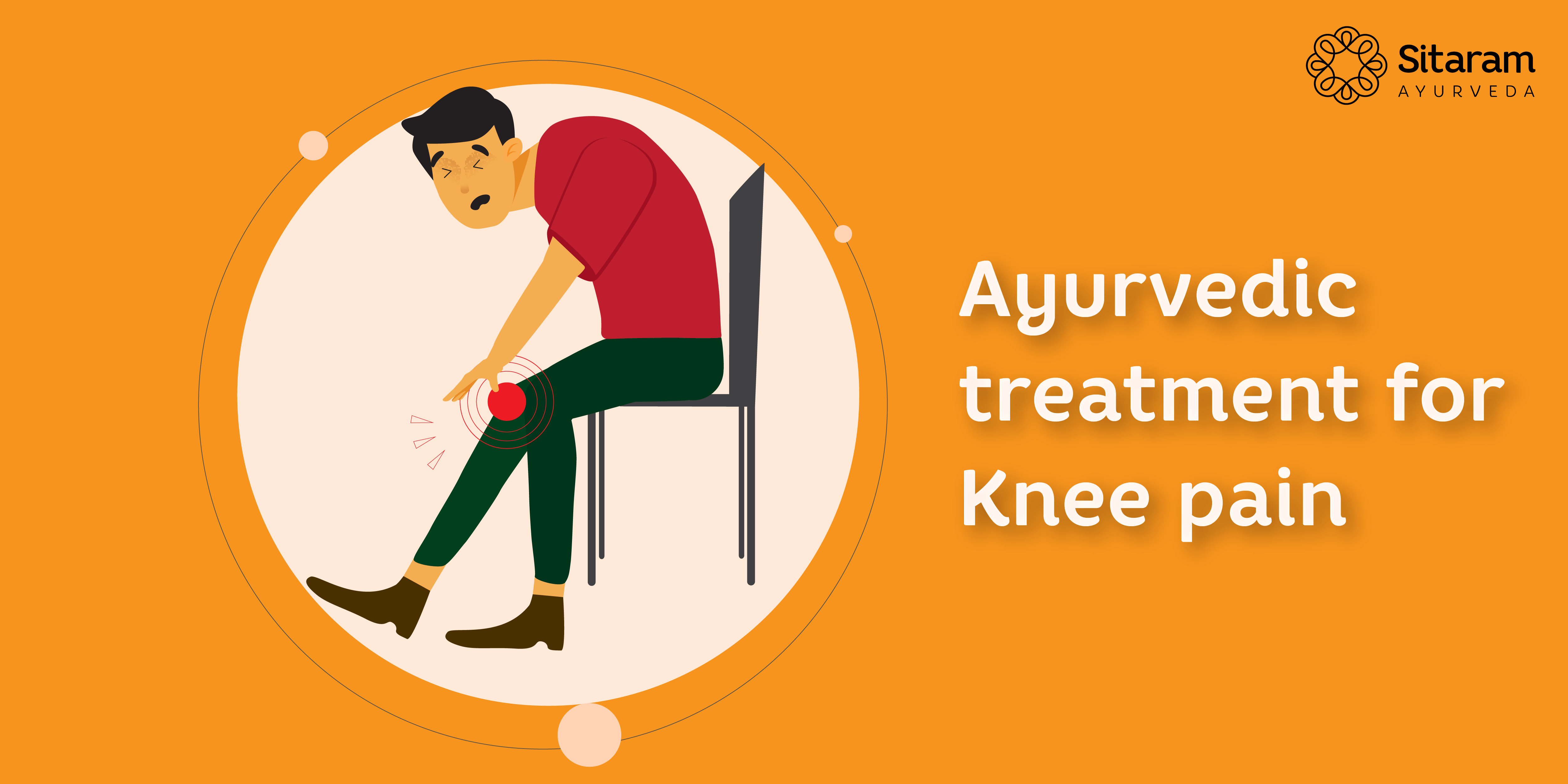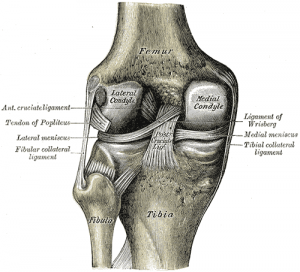Ayurvedic Treatment for Knee Pain

Knee is a primary weight bearing and mobility joint in our body. Its importance in basic mobility makes the knee joint susceptible to injuries, wear and tear. Thus knee pain is a common problem among both senior citizens and young adults.
In treating knee pain, most important is to understand knee pain and identify its causes accurately.
Understanding the knee joint:

Basically, the knee is a joint of 2 long leg bones plus the patella or the knee cap held together by muscles, ligaments, and tendons.
The bones of the knee joint are:
Femur: the thigh bone or upper leg bone.
Tibia: shin bone or larger bone of the lower leg.
Patella or the kneecap.
The main groups of muscles involved in the knee includes the quadriceps muscles (located on the front of the thighs), which straighten the legs, and the hamstring muscles (located on the back of the thighs), which bend the leg at the knee.
Tendons and ligaments connect the structures and stabilise the joint. Tendons are tough cords of tissue that connect muscles to bones. Ligaments are elastic bands of tissue that connect bone to bone. Ligaments on the knee provide stability and protection of the joint, and limit forward and backward movement of the tibia (shin bone).
The main ligaments of the knee are:
Anterior cruciate ligament (ACL) – The ligament, located in the center of the knee, controls rotation and forward movement of the tibia (shin bone).
Posterior cruciate ligament (PCL) – The ligament, located in the center of the knee, that controls backward movement of the tibia (shin bone).
Medial collateral ligament (MCL) – The ligament that gives stability to the inner knee.
Lateral collateral ligament (LCL) – The ligament that gives stability to the outer knee.
The ends of bones are covered by cartilages to reduce damage from rubbing together. The fibrous- cartilages in the knee are disc shaped and are called meniscus. (Singular is menisci.) There is a medial meniscus and a lateral meniscus.
What causes knee pain?
Knee pain can be from a number of causes. For ease of understanding we may classify them as acute and chronic.
Acute causes for knee pain mostly include injuries from sports, accidents etc. The common ones include:
Ligament Injuries: Ligament injuries of knee can be strain, sprain or tear. They are caused by sudden pulling and twisting movements (ACL injury), direct blow to back or front of knee (PCL injury) or direct blow to the sides (cruciate ligaments injury) of knee. Injury to cruciate ligaments do not often cause pain, but cause instability of knee joint and buckling. However, collateral ligament injury causes pain, swelling and instability of the knee joint.
Meniscal Tear: Meniscal injury can occur due to acute and chronic conditions. Acute injuries can happen when a person changes direction suddenly while running, and often occur with other knee injuries.
Menisci get weaker with age. Chronic meniscal tears are due to degeneration wear and tear and repeated stress. For people above 45 years, minimal stress to menisci may cause a tear.
The pain in both acute and chronic meniscal injuries are not severe at first. But soon inflammation sets in and causes swelling and immobility of the knee joint. Often the knee will get locked or ‘stuck’ while moving.
Dislocated kneecap (Patellar dislocation): Your kneecap may slide out of position if hit from the side. It will cause strong knee pain, swelling and immobility.
Four steps to follow immediately if you injure your knee suddenly:
The first aid till you visit your doctor is called RICE – rest, ice, compress, elevate.
- Rest the knee. Limit all movements of the knee.
- You can apply cold compress to reduce pain and swelling. Do it for 15-20 minutes every 3-4 hours.
- Compress your knee. Using an elastic bandage will help to control swelling.
- Elevate your knee with a pillow under your heel when you’re sitting or lying down.
How are knee injuries diagnosed and differentiated from each other?
If you have an acute knee injury, a qualified ayurvedic physician will do an evaluation of the knee joint. That will include asking you to perform some movements with your legs, holding certain positions, feeling and applying force to the joint etc. Sometimes, imaging like MRI or X-ray will be required to confirm the diagnosis.
What are the ayurvedic treatment for acute knee injuries?
Ayurvedic treatment for ligament injuries and ayurvedic treatment for meniscal tear depends on the extent of tear.
Patellar dislocation requires putting back the patella into place.
Treatment includes rest, immobilisation with medicated bandages in some conditions, anti inflammatory treatments like ‘dhara’ with medicated oils if necessary and rehabilitation exercises after controlling the inflammation. ‘Murivenna’ is one medicated oil commonly used in acute injuries which is a powerful anti-inflammatory and analgesic.
Ayurvedic internal medicines and external therapies will ensure faster recovery from injuries by reducing inflammation faster and by ensuring proper blood and nutrient supply.
Chronic conditions causing knee pain include:
Tendonitis: Inflammation of the tendons may result from overuse of a tendon during certain activities such as running, jumping, or cycling. Tendonitis of the patellar tendon is called the jumper’s knee. This often occurs with sports, such as basketball, where the force of hitting the ground after a jump strains the tendon.
Bursitis. Bursa is a fluid filled sac under the skin above your joint. It helps prevent friction when the joint moves. Overuse, falls, or repeated bending and kneeling can irritate the bursa on top of your kneecap. That leads to pain and swelling. Doctors call this pre patellar bursitis.It is also called ”preacher’s knee.”
Ilio – Tibial band syndrome. The iliotibial (IT) band is a piece of tough tissue that runs from your hip down to the outer part of your knee. When you overdo activity, it can become inflamed over time. That causes pain on the outer side of the knee. It’s common among athletes and those who climb too many steps and feel more when going downhill.
Chondromalacia patella (patellofemoral syndrome): It is one of the most common causes of chronic knee pain. The condition results from degeneration of cartilage under the patella due to poor alignment of the kneecap (patella) as it slides over the lower end of the thigh bone (femur). It is also called ‘runner’s knee’ and is considered as a result of overuse. Pain aggravates after standing up after sitting for a long time and while climbing stairs. The condition is mostly seen in younger, athletic people around 30 – 40 years of age.
Patellofemoral pain syndrome. Muscle imbalance, tightness, and alignment problems of the legs usually cause this condition. It causes knee pain and occasional “buckling,” meaning your knee suddenly can’t bear your weight. It’s not due to an injury.
Arthritis: Osteoarthritis is the most common type of arthritis that affects the knee. Osteoarthritis is a degenerative process where the cartilage in the joint gradually wears away. It often affects middle-age and older people. Osteoarthritis may be caused by excess stress on the joint such as repeated injury or being overweight. Rheumatoid arthritis, an autoimmune condition can also affect the knees by causing the joint to become inflamed and by destroying the knee cartilage.
Osgood-Schlatter disease. This condition happens mostly to children and teen agers who are athletic. It often causes a painful bump below the knee, where a tendon from the kneecap connects to the shin. The pain aggravates with activity or while kneeling and gets better by rest. The pain is worse with acute knee impact. The ache may come and go over time.
6 steps to prevent chronic knee problems:
- Ensure proper nutrition: Calcium and vitamin D deficiency is becoming more common and will affect knee health.
- Control your weight: Knee gets the burden of all the extra kilos you are carrying. Also, calcium deficiency tends to be more in overweight and obese people.
- Do exercise: Proper exercise maintains flexibility and ensures proper circulation and nutrient supply to all the structures associated with the knee.
- Do not overdo exercise: Overdoing exercise is the cause of many chronic knee issues. So do not tire yourself out. Stop immediately if you get any knee pain.
- Ensure proper form and position while doing exercise and sport: This will help to prevent both acute and repeated stress injuries and tendinitis.
- Treat acute injuries properly: Acute injuries when not taken care of can lead to chronic pain and inflammations later.
Ayurvedic treatment for knee pain:
Ayurvedic treatment for knee pain differs according to the condition. Mainly ‘vata’ and ‘pitha’ are the main ‘dosha’ involved in most knee issues. Chronic conditions with thick swelling and oedema includes kappa also.
The main aim of treatment is to reduce the inflammation, restore circulation and nutrient supply, prevent further damage, improve muscle strength and facilitate regeneration wherever possible.
Ayurvedic treatments often include medicines like ‘rasnadi kashayam’, ‘kaisora guggulu’, yogaraja guggulu’ etc., which reduce inflammation and swelling. Also external applications or ‘lepam’ with medicines like ‘nagaradi choornam’, ‘karuthavattu’ etc are done.
Treatments like ‘dhara’, ‘pichu’ with oils like ‘dhanwantaram kuzhambu’ will restore circulation and prevent degeneration. There are also strengthening treatments like ‘janu vasti’ and ‘njavara kizhi’.
Internal medicines like ‘isheeta guluchi’, ‘gandha tailam’ , ‘guggulu tiktakam ghee’ etc will improve the strength of all structures associated with the knee.
As differential diagnosis and identification of cause is important in better treatment of knee pain, we strongly recommend you to consult a qualified ayurvedic doctor near you before starting any treatment for knee pain. You may also avail our online consultation.
Please feel free to comment below regarding managing knee pain.


 Sign In
Sign In Cart
Cart
Kindly help me regarding the treatment of Runner’s Knee.
Hi
Please use the link for an online consultation –
https://www.sitaramayurveda.com/product/doctor-consultation/